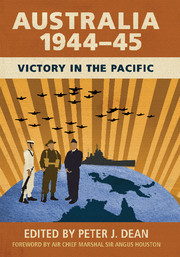Book contents
- Frontmatter
- Dedication
- Foreword
- Contents
- Maps and chart
- Figures and table
- Contributors
- Acknowledgements
- Abbreviations
- Military symbols on maps
- Introduction
- PART 1 STRATEGY
- PART 2 AUSTRALIA AT WAR
- PART 3 GREEN ARMOUR AND SPECIAL OPERATIONS
- PART 4 THE NAVAL AND AIR WAR
- PART 5 THE NEW GUINEA CAMPAIGN
- PART 6 THE BORNEO CAMPAIGN
- 12 Amphibious Warfare: Training and Logistics, 1942–45
- 13 ‘To capture Tarakan’: Was Operation Oboe 1 Unnecessary?
- 14 Unique in the history of the AIF’: Operations in British Borneo
- 15 ‘Calling the tune’: Australian and Allied Operations at Balikpapan
- Afterword: And Then Came Peace?
- Index
- References
14 - Unique in the history of the AIF’: Operations in British Borneo
from PART 6 - THE BORNEO CAMPAIGN
Published online by Cambridge University Press: 05 December 2015
- Frontmatter
- Dedication
- Foreword
- Contents
- Maps and chart
- Figures and table
- Contributors
- Acknowledgements
- Abbreviations
- Military symbols on maps
- Introduction
- PART 1 STRATEGY
- PART 2 AUSTRALIA AT WAR
- PART 3 GREEN ARMOUR AND SPECIAL OPERATIONS
- PART 4 THE NAVAL AND AIR WAR
- PART 5 THE NEW GUINEA CAMPAIGN
- PART 6 THE BORNEO CAMPAIGN
- 12 Amphibious Warfare: Training and Logistics, 1942–45
- 13 ‘To capture Tarakan’: Was Operation Oboe 1 Unnecessary?
- 14 Unique in the history of the AIF’: Operations in British Borneo
- 15 ‘Calling the tune’: Australian and Allied Operations at Balikpapan
- Afterword: And Then Came Peace?
- Index
- References
Summary
Writing of the work of Australian medical units among the people of Sarawak, Australia's official historian of the Second World War, Gavin Long, observed that it was ‘unique in the history of the AIF’. This epithet can be readily applied to the broader campaign conducted in British Borneo between March 1945 and January 1946 – the most multi-faceted set of operations conducted under Australian command during the Second World War. Not only did the British Borneo campaign share the extensive joint cooperation of the operations at Tarakan and Balikpapan, it also featured special and military civil affairs operations unprecedented in scale and scope during Australia's contribution to the war. The integration of these elements suffered from inadequate command and control structures and poorly coordinated objectives, but their presence clearly demonstrates a level of operational maturity not glimpsed in earlier Australian campaigns.
The campaign was also the most politically complex of those waged by Australia, and some of the difficulties in operational, and sometimes tactical, level coordination stemmed from the politico-strategic agendas underlying its direction. The use of ‘British Borneo’ in this chapter follows British Colonial office practice and refers to four separate territories: the Crown Colony of Labuan, a small island off the east coast of northern Borneo, and the protectorates of Sarawak, Brunei and North Borneo. Prior to the Japanese occupation all three of the latter had different forms of government – Sarawak was ruled by the fourth of the Brooke family's paternalistic ‘white rajahs’, North Borneo was under control of a governor appointed by the directors of the British North Borneo Company, and Brunei by its hereditary Sultan with advice from a British resident. The Colonial Office had plans for post-war administrative reform in the territories, and with the deeply wounded British economy needing their supplies of oil, rubber and minerals, regarded the United States’ anti-colonial agenda with suspicion. Thus, at a time when the British Joint Chiefs questioned the military necessity of capturing Brunei Bay to secure a naval base they did not want – as discussed in Chapters 1 and 2 – other elements of the British government were keen for an early return.
- Type
- Chapter
- Information
- Australia 1944–45Victory in the Pacific, pp. 298 - 319Publisher: Cambridge University PressPrint publication year: 2015



